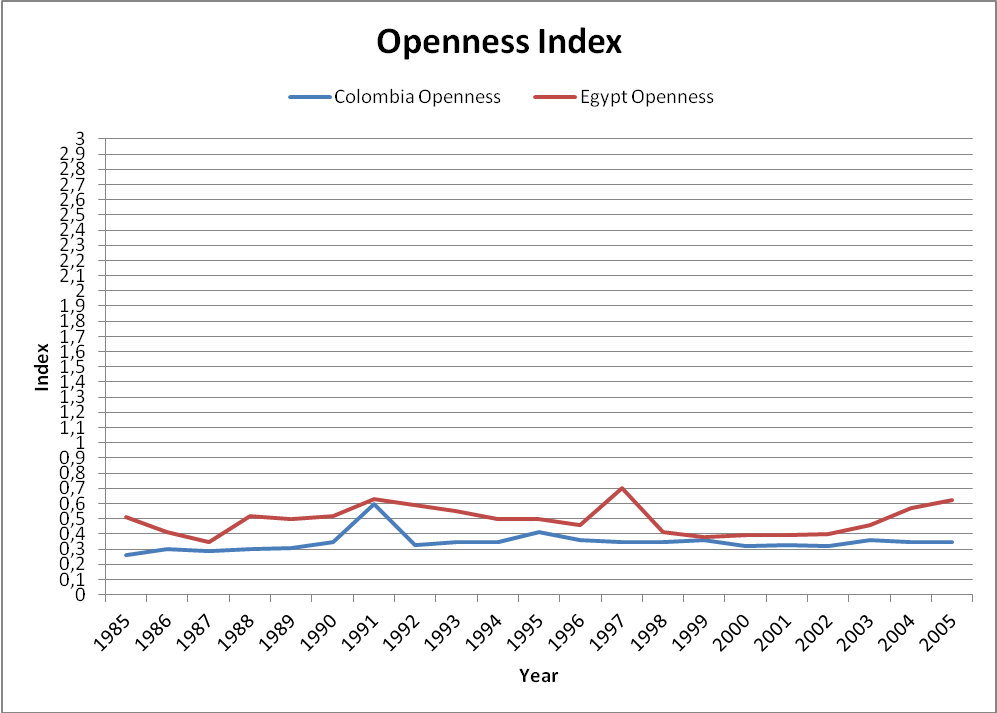Introduction
The data regarding GDP, GDP per capita, imports of goods, and exports of goods were retrieved for Colombia and Egypt from the World Bank’s World Development Indicators database (World Data Bank par. 2). The data selected for the examination were related to the period of 1985-2005. The purpose of this paper is to describe the openness tendencies for Colombia and Egypt, discuss the relationship between openness and development of countries, and analyze factors influencing openness.
Openness in Colombia and Egypt
Figure 1 presents changes in the openness index for Colombia and Egypt typical of the 1985-2005 period (World Data Bank par. 2). The openness index was calculated the following way: the annual sum of all exports and imports for the country was divided by the annual gross domestic product (GDP) with the focus on real terms (McGovern 134).

In Colombia, the openness index did not change significantly in 1985-2005. The index increased considerably only in 1991, demonstrating the increases in exports and imports. In Egypt, stable growth is observed for the period of 2000-2005. The extreme increase in the index was observed in 1997.
Relationship between Openness and Countries’ Development
The correlation coefficient for GDP per capita and openness related to Colombia is 0.3218. It demonstrates that, in Colombia, it is possible to speak about the low or almost moderate correlation between the growth in GDP and increases in exports and imports. Thus, it is possible to expect that increases in exporting and importing products and services will be associated with positive changes in the country’s GDP, demonstrating the economic growth.
The opposite situation is observed in relation to Egypt. The calculated correlation coefficient is 0.0120. Therefore, it is possible to state that there is almost no actual relationship between openness and changes in the GDP per capita, reflecting the economic development of the country. Increases in exports and imports cannot lead to positive changes in the GDP of Egypt.
Factors to Drive Openness
In Colombia, the factors that drive openness are the privatization of properties and facilities, as well as the strengthening of the private sector in the country (Shahbaz 128). In addition, openness depends on the trade agreements that the country has signed with foreign nations. The barriers associated with regulations of international trade can have a negative impact on the country’s openness, and much attention should be paid to simplifying procedures that are used to regulate trade relations (Feenstra 56). Labor, transportation, resources, and insurance are usually regarded as negative factors in relation to Colombia and the development of international trade in contrast to developed countries because this nation has limited resources to realize its potential for openness (Shahbaz 128).
In Egypt, the driving factors include the implementation of technologies in organizations in order to optimize processes. Another factor is the attraction of investors from the Arab countries supporting the economic development in the region (Elshennawy 328). In addition, much attention is paid to relocating facilities and optimizing operations because the environments of Egypt are not favorable to support the production in this country (Haddad 767). As a result, while discussing openness, much attention should be paid to imports. In order to contribute to increasing openness and GDP of the country, the leaders of Egypt need to pay attention to attracting foreign investments to support the country’s participation in international trade.
Works Cited
Elshennawy, Abeer. “The Euro-Mediterranean Free Trade Agreement and the Cost of Tariff Liberalization in Egypt.” Journal of Policy Modeling 35.2 (2013): 326-338. Print.
Feenstra, Robert. Advanced International Trade: Theory and Evidence. New York: Princeton University Press, 2015. Print.
Haddad, Mona. “Trade Openness Reduces Growth Volatility When Countries Are Well Diversified.” Canadian Journal of Economics 46.2 (2013): 765-790. Print.
McGovern, Edmond. International Trade Regulation. New York: Globefield Press, 2016. Print.
Shahbaz, Muhammad. “Causality between Trade Openness and Energy Consumption: What Causes What in High, Middle and Low Income Countries.” Energy Policy 70.1 (2014): 126-143. Print.
World Data Bank. World Development Indicators. 2016. Web.